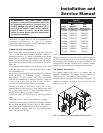
Hydronic Heating Boilers and
Domestic Water Heaters
30
INSTALLATION
Continued
Water heater models do not have downstream test valves, but
the rest of the gas train is represented by Figure 29.
Combination Gas Valves
These units fire in multiple stages of burner input. Each stage
of burner operation has a combination gas valve(s) to cycle the
gas supply on and off and regulate gas to the burners. Each
combination valve consists of a gas regulator and two valve
seats to meet the requirements for redundant gas valves. The
valve has a gas control knob that must remain in the open
position at all times when the unit is in service. The gas control
valve has pressure taps located on the inlet and discharge sides
of the valve. Manifold pressure is adjusted using the regulator
located on the valve. A manifold gas pressure tap for each
burner stick is located on the discharge side of the valve.
The manifold pressure is preset at the factory and adjustment
is not usually required. If you must adjust regulator pressure,
follow the instructions under Gas Manifold Pressure
Adjustment, page 31.
Venting of Combination Gas Valves
The combination gas valve/regulator used on all units is
equipped with an integral vent limiting orifice per ANSI
Z21.78. The vent limiter ensures that the volume of gas
emitted from the valve in the event of a failed gas diaphragm
does not exceed the maximum safe leakage rate allowed by
agency requirements. Combination gas valve/regulators
equipped with integral vent limiters are not required to have
vent or relief lines piped to the outdoors. The termination of
the vent limited opening on the combination gas
valve/regulator complies with the safety code requirements of
CSD-1, CF-190(a) as shipped from the appliance manufacturer
without the installation of additional vent lines.
Checking Gas Supply Pressure
Use the following procedure to check gas supply pressure.
1. Turn the main power switch to the “OFF” position.
2. Turn gas valve knobs to the “OFF” position.
3. Shut off gas supply at the field-installed manual gas cock
in the gas piping to the unit. If fuel supply is L.P. gas, shut
off gas supply at the tank.
4. Remove the 1/8" hex plug, located on the “inlet” side of
the gas valve. You may also use a tapping on the field-
installed main manual gas cock or gas piping. Install a
fitting in the inlet pressure tapping suitable to connect to a
manometer or magnehelic gauge. Range of scale should be
14" w.c. or greater to check inlet pressure.
5. Turn on gas supply at the manual gas cock, turn on L.P. gas
at the tank if required.
6. Turn the power switch to the “ON” position.
7. Turn the gas valve knobs to the “ON” position. Set the
electronic temperature control or thermostat to call for
heat.
8. Observe the gas supply pressure as all burners are firing.
Ensure that inlet pressure is within the specified range. See
Connecting To Gas Supply, page 28 for minimum and
maximum gas supply pressures.
9. If gas pressure is out of range, contact gas utility, gas
supplier, qualified installer or service agency to determine
necessary steps to provide proper gas pressure to the
control.
10. If gas supply pressure is within normal range, turn the
power switch to the “OFF” position.
11. Turn gas valve knobs to the “OFF” position.
12. Shut off gas supply at the manual gas cock in the gas
piping to the unit. If fuel supply is L.P. gas, shut off gas
supply at the tank.
13. Remove the manometer and related fitting from the “inlet”
side of the gas valve, replace 1/8" hex plug in gas valve
and tighten.
14. Turn on gas supply at the manual valve, turn on L.P. gas at
the tank if required.
15. Turn the power switch to the “ON” position.
16. Turn the gas valve knob to the “ON” position.
17. Set the electronic temperature control or thermostat to call
for heat.
ƽ WARNING: After completing any testing on
the gas system, leak test all gas connections.
Apply a soap/water solution to all gas connections
while main burners are operating. Bubbles
forming indicate a leak. Repair all leaks at once. Do
not operate this unit with a leak in the gas train,
valves or related piping.


















